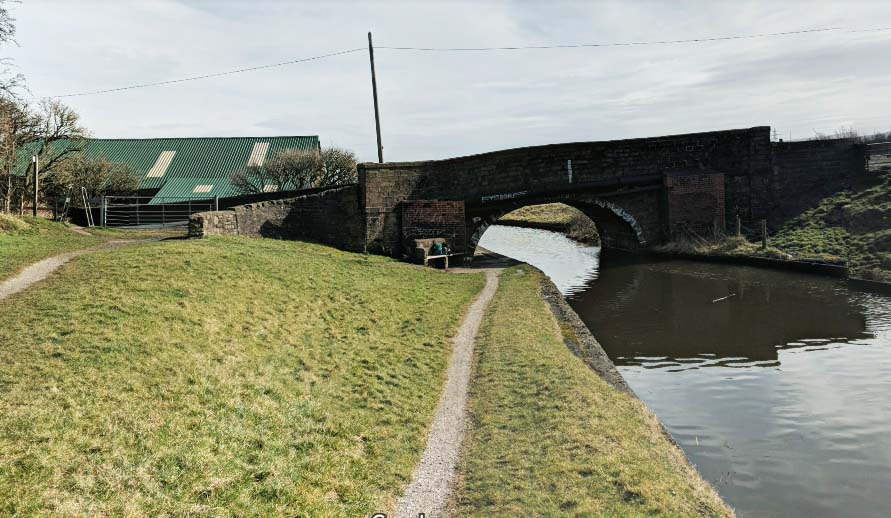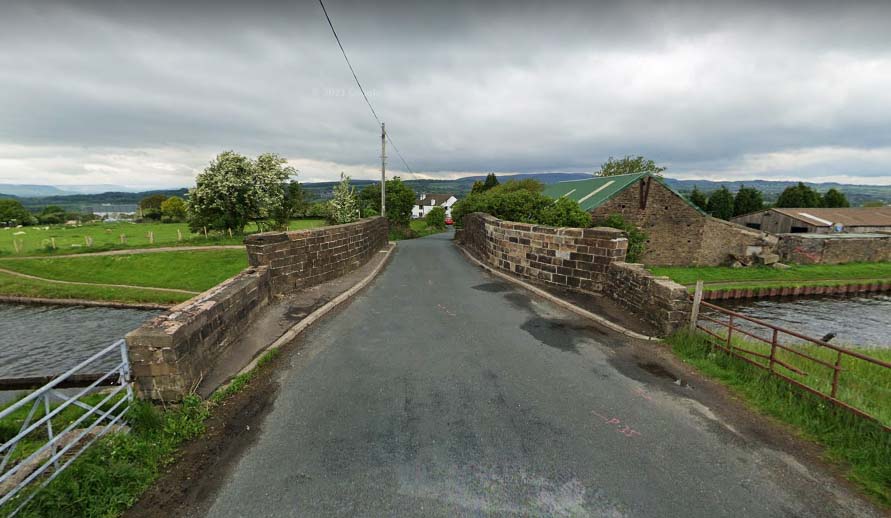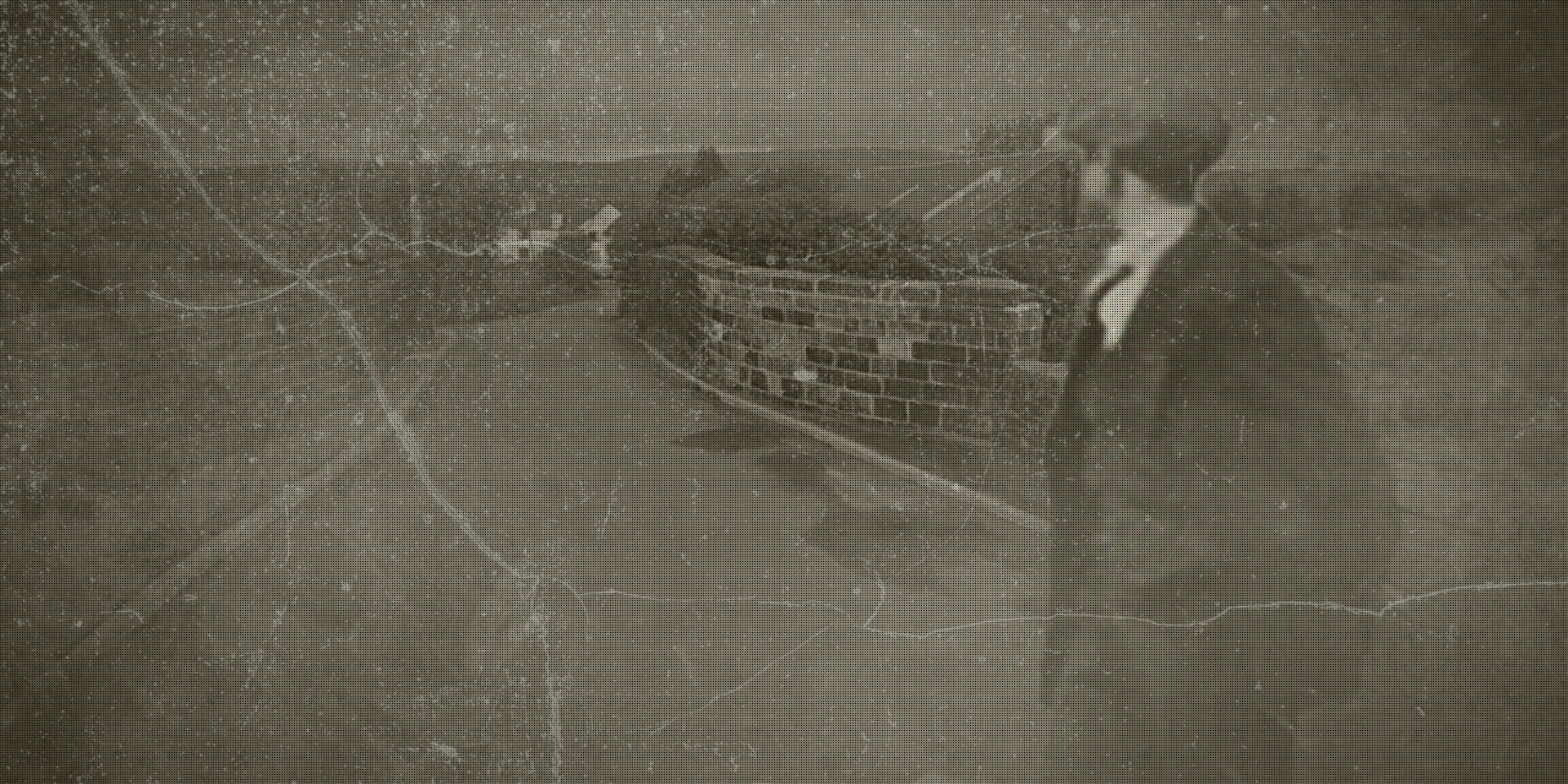![]()
The walk from Smiths Place Farm, that was situated just on the outskirts of the small village of Huncoat, to the home of Susannah Holt at Houghton Barn Farm in Altham, is roughly just one mile in distance and something which would usually take on average, around fifteen to twenty minutes to complete.
And this walk was nothing unusual for James William Walker, who was just sixteen years old back on the 16th September 1889, when our next story takes place.
It had been a relatively mild day with just the odd outburst of rain which had blighted pretty much all of the North West of England, and for September, it felt much warmer than usual.
Making his way on the uneven and at times slippery footpath alongside the Leeds and Liverpool Canal, it was around 8.00pm when James would eventually arrive at a small bridge that overlooked the canal. He was also only around 100 yards from Houghton Barn Farm, the home of is aunt, Susannah Holt.
As James left the muddy footpath and began the short walk to his aunt’s farm, he noticed the figure of a young man stood next to a fence on the opposite side of the path.
“Eigh, mate, has ta got a copper?” asked the stranger.
James replied with a simple ‘no’ as he passed the stranger.
Moments later, the stranger caught up with James, saying; “Good night” as he put one of his arms around James’ neck.
Thinking the stranger was larking around, James tried to shrug him away but as he tried his hardest to break free, the stranger drew something that glittered from his breast pocket with his right hand.
Seconds later, and not realising what was happening to him, James then felt a piercing pain emanating from the left hand side of his abdomen.
With a sharp instrument, the stranger began stabbing James, not once or twice, but five times in total.
James screamed in pain and managed to break free of the strangers hold and began to run towards his aunt’s house. Upon arriving, he shouted “I’m stabbed!” as he slumped into a chair. As his aunt quickly came to his aid, James would tell her that a well-dressed man had stabbed in on the canal bridge, but before she could question him any further, James fainted from his ordeal.
His aunt, shocked after witnessing her nephew arrive in such a state and obviously panicking that he had fainted, she quickly summoned for help and it wouldn’t take long for both P.C. Saggerson and Dr. Law to arrive at the farm.
Dr. Law attended to the wounds on James’ abdomen, stopping the bleeding and whilst the injuries were not of a very serious character, he was more worried about his mental state as James was suffering terribly by fright.
The cuts made to James abdomen were around an inch and a half in length and a quarter of an inch deep. They had bled quite badly by the time both the police and Dr. Law arrived and blood had covered large potions on his clothing.
After waking, P.C. Saggerson would manage to get a description of James’ attacker. He would tell Saggerson that he was well dressed, with a short top-coat and a billycock. He was also around 5ft. 5in high – roughly the same height as James.
James would stay the night at Houghton Barn Farm, but it seems he suffered badly from panic as he would cry out several times, “Don’t kill me,” whilst throwing his arms around in a violent struggle. At times, it would take three people to hold him down such was his violent outbursts. Even his uncle, Lawrence Ashworth, who was a heftily built man would struggle to contain him at times.
The next day, the police would begin investigating the attack on James and it was apparent early on that they felt he possibly had known who his assailant was, but despite questioning him, he was very reticent.
As news spread throughout the day, folk would soon began spreading rumours and talk would quickly turn to the infamous Whitechapel murders, with the name of Jack the Ripper being mentioned in some quarters, such was the fear instilled in people’s minds from the brutal murders that had taken place in London less than a year before.
Despite carrying out a thorough investigation, the police would make no arrest and it was believed that they had good grounds for believing that, whilst they may have known who stabbed James, they found it very difficult in getting any positive proof as James was, for whatever reason, unwilling to give them any further information about his attacker.


A theory they would soon make was that jealousy was the cause of the stabbing but they couldn’t do anything if James was unwilling to give evidence that would bring his assailant to court.
A month would quickly pass by, and despite the police carrying on with their investigations, nothing more would come of the man who had attacked James on the 16th September.
On the 16th October, and after spending the last three weeks in a delirious condition, sadly, James Walker would pass away.
The wounds inflicted upon him had almost healed up but for the previous three weeks, James had rambled about bayonets, knives, swords and policemen, and he would barely recognise anyone who had been attending to him.
During the last week of his life, he neither ate nor drank anything and as his life slowly ebbed away, he had become totally blind.
Two days after the death of James, an inquest was opened by Mr. F. D. Robinson (deputy coroner) at the Walton Arms public-house in Altham, with Mr. Hugh Pritchard the chosen foreman of the jury.
Police Inspector Hind, Police Sergeant Turner and Police Constable Saggerson were also in attendance.
James’ father, Thomas was first to be questioned, and he would tell the jury that James had been a labourer at the Chemical Works in nearby Hapton and that on the 16th September he had left home at Smith Place Farm to fetch his grandmother from Houghton Barn Farm.
Three quarters of an hour later, Thomas had seen his son James sitting on a chair inside Houghton Farm being comforted by a lady by the name of Mrs. Mary Cecilia Irvine.
She was the wife of Dr. Irvine, of Mill Street, Clayton-le-Moors and had been visiting Susannah Holt at the farm on the evening of the attack.
Seeing his son in such a state and after speaking to Mary Irvine, James told the jury that he ran out of the house in hope of catching his sons assailant, telling them it was only around three minutes or so between being told of the attack and him leaving the farm to go to the bridge and the scene of the attack. There was no one around when he got there.
Dr. Thomas Charles Law was next to take to the stand. He would tell the jury of how, after arriving at the farm, he had found James in a ‘swooning’ condition and when he came out of the ‘swoons’, he was scared as if he had received or been involved in a frightening confrontation.
Dr. Law examined the wounds, removing the bandage and compress that Police Constable Saggerson had placed over them.
As already mentioned, he had suffered from five wounds, which seemed to be nothing more than a scratch. Three more seemed to be much longer and slightly deeper and had bled quite badly.
He would tell the jury that James would suffer from convulsions during the first week, with some being exceedingly strong that it seemed that they could turn fatal.
Sometimes it would also take three and four people to hold James down, such was the ferocity of the fits he was having.
In answer to a question by the foreman, Dr. Law would say that several times when James was having fits, he would implore; “Oh! dont kill me!” with occasional outburts of “Oh! dont stab me!”
Susannah Holt, wife of William Holt and aunt of James Walker was next to be questioned. She told the jury that on the evening of the attack, she had seen James on Houghton-Lane at around 6.50pm and had asked him to go home with his grandmother.
It was at this time that Mary Irvine appeared and James had asked her what time she was going home. Mary replied, telling him she could not catch the 7.40pm train and James said he would come back and walk along the bank.
Having left James alone, both Mary and Susannah then made their way to Houghton Farm.
Susannah would then describe the moments when James ran into the kitchen holding his hands to his side. Both Susannah and Cecilia immediately left the house but saw nobody else around.
Mary Irvine was then called to give evidence and perhaps she is the key witness in this tragic story.
Appearing in court, she was dressed in a dark blue dress, cloth jacket, and wore a hat trimmed with dark red ribbon and feathers. Young in appearance, she was, however, much older than James.
She stated that she had known James for around five to six years and he had been an ‘intimate’ visitor to her house.
On Saturday, 14th September – just two days before the attack, she had travelled with James on the last train from Huncoat to Accrington and after that they went to her residence in Clayton-le-Moors. Her husband was not present when they arrived but he returned home whilst James was lighting a fire.
Mary then left her house for a short time, but on her return she found James outside who told her that the doctor had locked him out of the house.
She knocked on the door, requesting Dr. Irvine to let them in but he refused.
Mary would then tell the jury that she and James both went to the police station and shortly after, a police sergeant went back to the house with them.
When asked to be let back in, Dr. Irvine opened the door, telling Mary that she could come in, but James was not allowed.
When questioned about her husbands mental state of mind on that evening, she would reply saying he had been drinking.
James, instead of making his way back home, instead went over to a neighbours house opposite that of Dr. Irvine, and stayed the night there.
The next day, Sunday 15th September, Mary would admit to seeing James for much of the day, either at the neighbours house or at her own house when Dr. Irvine had left.
She would also tell of how she had travelled with James that day back to Houghton Farm to have tea later that afternoon and when asked if James had taken her back to Clayton-le-Moors that same evening, she replied yes, but could not recall the time, only saying it was sometime between seven and eight o’clock.
The Foreman of the jury then procedeed to quiz Mary over her relationship with James, and how it could possibly effect the mind of her husband, Dr. Irvine;
Foreman – “I suppose he had a quarrel with your husband on Saturday night?”
Mary – “No, he had no quarrel.”
Foreman – “There was a disturbance then?”
Mary – “He refused to let me in.”
Foreman – “If the deceased was on such friendly terms, why did he refuse to let him in?”
Mary – “I should think its because he had drink in him.”
Foreman – “I suppose he had no objection to the deceased’s escorting you back and forward in the manner described?”
Mary – “Oh, no.”
Foreman – “Can you give us any better reason than that of his being in drink which would cause him to lock the deceased out?”
Mary – “Oh, no.”
Foreman – “At all times previous to this time mentioned he had allowed the deceased to escort you home?”
Mary – “Yes.”
It seems that the Foreman of the jury was indeed trying to insinuate that Mary’s relationship with James was more that of just being friends and perhaps Dr. Irvine was jealous.
Henry James Crossley would also take to the stand. He was the foreman at the same chemical works in Hapton that James had also worked at and he would tell of how James seemed to have been in a dull and ‘sackless’ mood on the Monday of the attack. Normally, he would be full of life and had never hinted before that something was bothering him.
The Coroner in summoning up, said the case was a peculiar one but that the doctor had pretty much given a straight answer in that death was due to congestion of the brain, possibly accelerated by the fright of the attack upon the deceased or by wounds being self-inflicted.
However, if the wounds had been caused by somebody else, it would be the duty of the jury to return a verdict of murder against some person or persons unknown – but there was no evidence to show how the wounds were really caused.
It was strange how the wounds on the body did not correspond with the cuts in the boys shirt – there with only two cuts in the shirt and yet five on the body? And the cuts in the shirt where higher than those found on the body.
The only verdict, therefore, could be that James had died from brain fever, and might have been accelerated by fright. He thought they could only record an open verdict.
The jury then retired, returning just fifteen minutes later. And just as the Coroner had asked, they returned an open verdict.
The inquest only lasted for two hours.

As for James William Walker, no one will ever know the true cause of his death. Questions will always remain. Was he attacked on the bridge just 100 yards from his aunts house? Or were the wounds self-inflicted and he was suffering from some form of mental illness in the build up to his death?
Perhaps there is some truth in what the Foreman of the Jury was impyling in that Dr. Irvine may have been jealous of his wifes relationship with James and it was him who may have attacked James on the bridge that evening?
We will never know.
James’ body was interred within the grounds of St. James Church, Altham on the 19th October 1889.
Sources used in this story;
Burnley Express – Wednesday 18 September 1889
Blackburn Standard – Saturday 21 September 1889
Lancashire Evening Post – Thursday 17 October 1889
Blackburn Standard – Saturday 19 October 1889
Oxfordshire Weekly News – Wednesday 23 October 1889
+ many more courtesy of the British Newspaper Archive – www.britishnewspaperarchive.co.uk and www.ancestry.co.uk
Please follow me on social media;
Twitter – https://twitter.com/dohpods
Instagram – www.instagram.com/dohpods
Youtube – https://www.youtube.com/c/DaysofHorrorPodcast
Music;
Casual Desire – Ugonna Onyekwe – No Copyright Music
Contact – The Tower of Light – No Copyright Music
Classical Piano – Myuu – No Copyright Music
Identity Crisis – Myuu – No Copyright Music


Leave a Reply